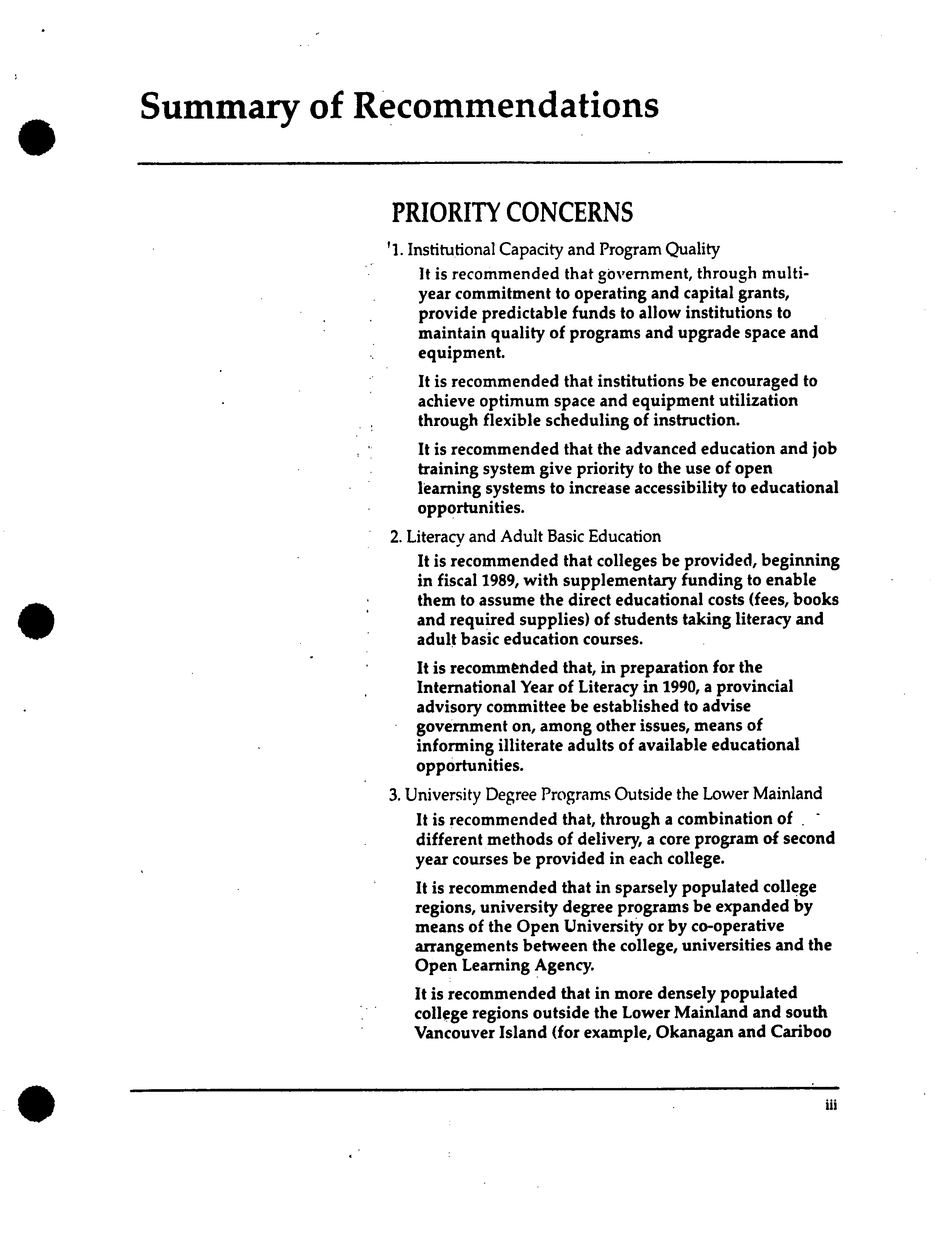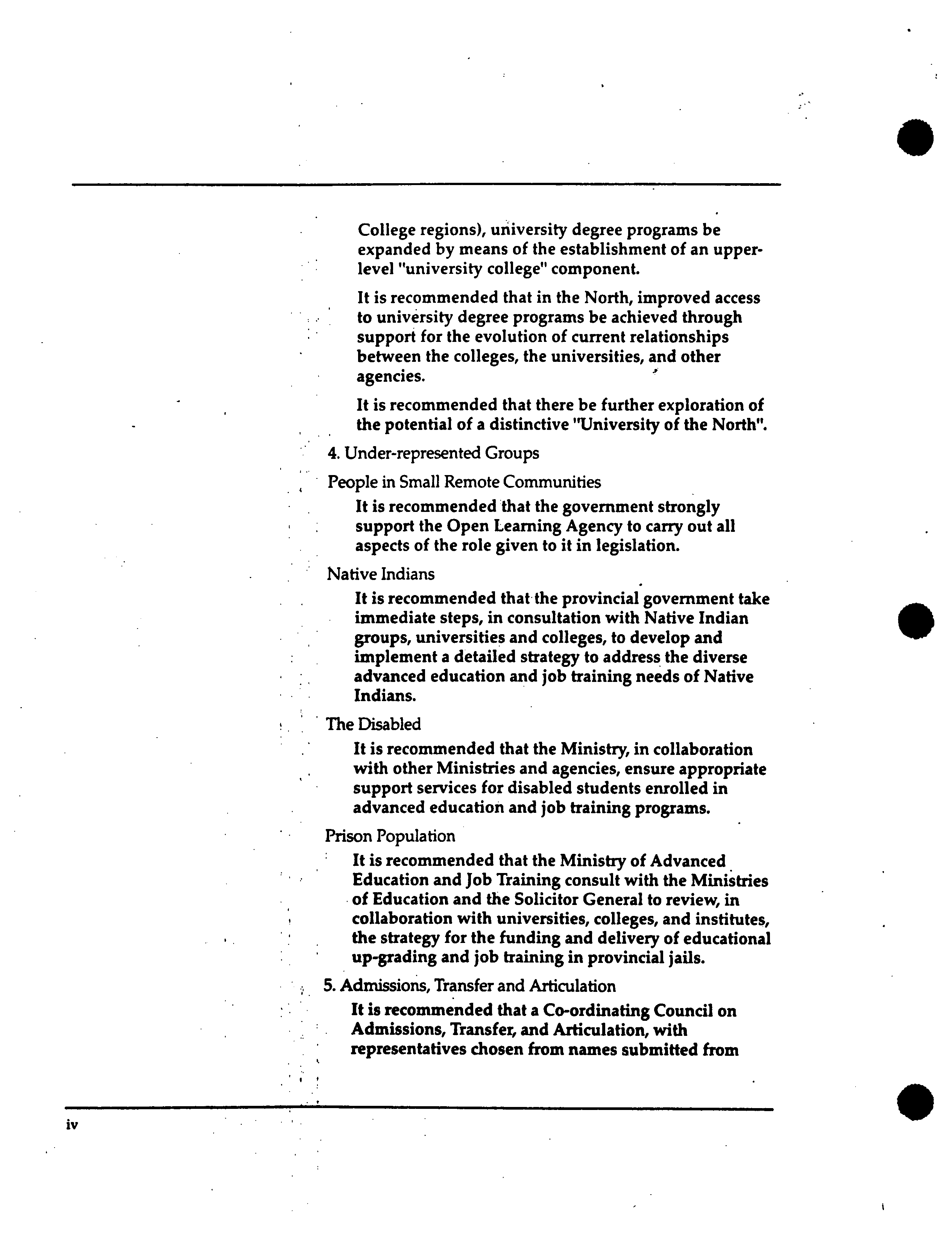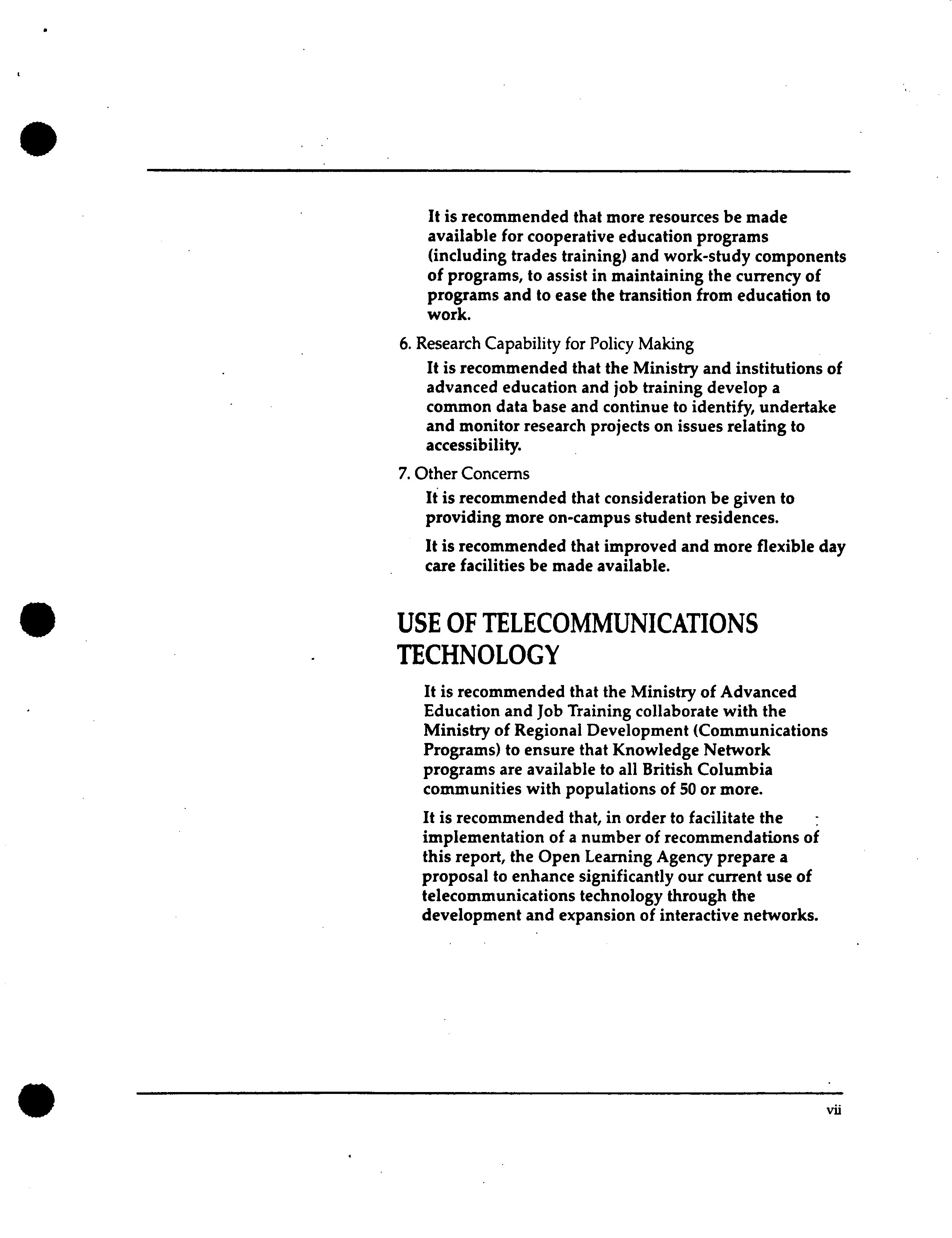FOR INFORMATION
dW
41
.i
ACCESS TO ADVANCED EDUCATION AND
JOB TRAINING IN BRITISH COLUMBIA
REPORT OF THE PROVINCIAL ACCESS COMMITTEE
Submitted to
The Hon. Stanley B. Hagen
Minister of Advanced Education
and Job Training
Victoria, British Columbia
September, 1988
Summary of Recommendations
PRIORITY CONCERNS
'1. Institutional Capacity and Program Quality
It is recommended that government, through multi-
year commitment to operating and capital grants,
•
provide predictable funds to allow institutions to
maintain quality of programs and upgrade space and
equipment.
It is recommended that institutions be encouraged to
achieve optimum space and equipment utilization
through flexible scheduling of instruction.
It is recommended that the advanced education and job
training system give priority to the use of open
learning systems to increase accessibility to educational
•
opportunities.
2.
Literacy
and Adult Basic Education
It is recommended that colleges be provided, beginning
in fiscal 1989, with supplementary funding to enable
:them to assume the direct educational costs (fees, books
and required supplies) of students taking literacy and
adult basic education courses.
It is recommended that, in preparation for the
International Year of Literacy in 1990, a provincial
advisory committee be established to advise
government on, among other issues, means of
informing illiterate adults of available educational
opportunities.
3.
University Degree Programs Outside the Lower Mainland
It is recommended that, through a combination of • -
different methods of delivery, a core program of second
year courses be provided in each college.
It is recommended that in sparsely populated college
regions, university degree programs be expanded by
means of the Open University or by co-operative
arrangements between the college, universities and the
Open Learning Agency.
It is recommended that in more densely populated
college regions outside the Lower Mainland and south
Vancouver Island (for example, Okanagan and Cariboo
.
iii
College regions), university degree programs be
expanded by means of the establishment of an upper-
level "university college" component.
It is recommended that in the North, improved access
to university degree programs be achieved through
support for the evolution of current relationships
between the colleges, the universities, and other
agencies.
It is recommended that there be further exploration of
the potential of a distinctive "University of the North".
4. Under-represented Groups
• People in Small Remote Communities
It is recommended that the government strongly
support the Open Learning Agency to carry out all
aspects of the role given to it in legislation.
Native Indians
It is recommended that the provincial government take
immediate steps, in consultation with Native Indian
groups, universities and colleges, to develop and
implement a detailed strategy to address the diverse
advanced education and job training needs of Native
Indians.
• The Disabled
It is recommended that the Ministry, in collaboration
with other Ministries and agencies, ensure appropriate
support services for disabled students enrolled in
•
advanced education and job training programs.
Prison Population
It is recommended that the Ministry of Advanced
Education and Job Training consult with the Ministries
of Education and the Solicitor General to review, in
collaboration with universities, colleges, and institutes,
the strategy for the funding and delivery of educational
up-grading and job training in provincial jails.
5.
Admissions, Transfer and Articulation
It is recommended that a Co-ordinating Council on
Admissions, Transfer, and Articulation, with
•
representatives chosen from names submitted from
.
iv
.
.
within the system, be established to provide a
mechanism for the resolution of difficulties which may
arise from time to time with respect to admissions,
course and program equivalency, degree requirements,
and transfer of course credits.
ADDITIONAL CONCERNS
1.
Program Offerings in the Lower Mainland
It is recommended that the Henderson Report (see
Appendix A), supporting degree granting status
through the Open Learning Agency for the Emily Carr
College of Art and Design, be endorsed in principle by
the Ministry of Advanced Education and Job Training,
and that the Ministry refer the proposal to the Open
Learning Agency for evaluation and action.
2.
Program Offerings in Smaller Communities
It is recommended that the Ministry of Advanced
Education and Job Training provide the resources to per-
mit colleges to establish more learning centres in smaller
communities to facilitate the offering of a greater range
of courses and programs, on a scheduled and predictable
basis, (utilizing open learning communication
technologies as well as face-to-face instruction).
It is recommended that there be cyclic offerings of
vocational and technical programs and courses in
smaller and more remote communities, on a planned
three to five year basis.
It is recommended that short term refresher and -
upgrading courses for industry be offered in small
communities, utilizing mobile training facilities as
appropriate.
3.
Financial Barriers
It is recommended that the British Columbia Student
Assistance Program be given more publicity.
It is recommended that Regional Access Committee
recommendations regarding student financial
assistance be forwarded to the Standing Committee on
Student Financial Assistance for review and action.
.
.
-v
4.
Informational Barriers
It is recommended that ongoing counselling services be
more readily available, especially in interior colleges
where' students have less access to community
information and counselling services than students in
larger centres.
It is recommended that the existence of quality
educational opportunities through open learning
systems be more effectively conveyed to
all residents of
British Columbia.
It is recommended that the Ministry of Education
continue its efforts to make available more course
options in small secondary schools, particularly in
academic subjects, and particularly through the use of
distance learning technologies in situations where
course registrations are low.
It is recommended that Discovery Training Network
terminal access points (TAPS) be set up in all secondary
schools.
5.
Retention, Completion and Transition to Work
It is recommended that legislation be changed to allow
colleges to grant associate degrees.
It is recommended that British Columbia's educational
institutions place a higher emphasis on guidance and
student services so that students are given more
specific direction with respect to prerequisites,
entrance requirements, program expectations and
transition to work.
It is recommended that educational institutions place
increased emphasis on quality of teaching and the
development of teaching skills.
It is recommended that colleges and institutes make
provision for more sports, cultural and extra-curricular
activities.
It is recommended that specific career-technical and
vocational certificate programs be expanded where
there are
high
employment needs.
.
S
vi
.
It is recommended that more resources be made
available for cooperative education programs
(including trades training) and work-study components
of programs, to assist in maintaining the currency of
programs and to ease the transition from education to
work.
6.
Research Capability for Policy Making
It is recommended that the Ministry and institutions of
advanced education and job training develop a
common data base and continue to identify, undertake
and monitor research projects on issues relating to
accessibility.
7.
Other Concerns
It is recommended that consideration be given to
providing more on-campus student residences.
It is recommended that improved and more flexible day
care facilities be made available.
.
USE OF TELECOMMUNICATIONS
TECHNOLOGY
It is recommended that the Ministry of Advanced
Education and Job Training collaborate with the
Ministry of Regional Development (Communications
Programs) to ensure that Knowledge Network
programs are available to all British Columbia
communities with populations of 50 or more.
It is recommended that, in order to facilitate the
implementation of a number of recommendations of
this report, the Open Learning Agency prepare a
proposal to enhance significantly our current use of
telecommunications technology through the
development and expansion of interactive networks.
.
Vii
CONSULTATION TOPICS
The following topics and questions. are intended to focus your
comments to the consultative panel from the
.
Ministry of Advanced
Education and 3ob Training. So far as possible your remarks
should reflect your assessment of the needs of the whole
Province,
rather than those of your own institution or region.
1.
The Provincial Access Committee has proposed the
establishment of one or more "university colleges" in
British Columbia; each would be a component of a regional
college and would involve cooperation between a regional
college and the provincial universities, and would offer
programs leading to a university degree. Is this a viable
project and would it satisfactorily meet a need? Would it
be likely to generate sufficient enrolment to be cost
effective? What program areas should be represented?
2.
The Provincial Access Committee and the Ministry of
Education have both proposed offering basic education, free
of charge, to adult citizens of British Columbia. What are
the problems in attracting and retaining adults in literacy
and basic education programs? What special contribution can
post-secondary institutions make to this process?
3.
Post-secondary education in British Columbia is provided by
a large number of autonomous institutions of many types,
with different roles and different admission requirements..
To what extent and in
'
what ways would it be feasible and
advantageous for these institutions to function as a
system? Should regional colleges take increasing
responsibility for the first two years of Arts and Science
education? How can equal opportunity be provided for
college and university students to enter 3rd year programs?
4.
Overall approximately 60% of British Columbia high schaol
graduates enter post-secondary programs (academic or
technical), although the rate varies
,
greatly from one part
of the Province to another. Given that there is a positive
correlation between years of post-secondary education and
employment rates, should we concentrate on reducing
inequities or on raising overall transition rates? Are the
barriers primarily financial, or are social and cultural
factors also
important? What strategies should be employed
to increase the transition rate and on what groups should
they be targetted? Wouid'the Provincial Access Committee's
recommendation regarding program offerings in smaller
communities help to increase transition?
5.
British Columbia compares unfavourably with other Canadian
provinces in the percentage of post-secondary-students who
complete their programs and receive a diploma or degree.
What are the causes of this attrition? How best can the
completion rate be increased? Would the establishment of :a
degree of Associate encouraoe students to complete two year
programs. Would it tend to reduce-the completion rate of
baccalaureate degrees?
6.
What is currently being done to assist students in the
transition from post-secondary education to permanent
employment after graduation? Should greater efforts be
made? What form should these efforts take? To what
extent
-should this be a responsibility of individual institutions?
7.
Bow can an appropriate balance be achieved, in post-
secondary programs, between the educational,
social, and
occupational needs of the individual and the economic and
cultural needs of society? Should there be some change of
emphasis during the next five years and, if so, in what
direction?
S.
The Provincial Access Committee has recommended that
additional attention be given to the educational needs of
currently under-represented groups: e.g. Native peoples, the
disabled, and residents of remote communities. Are there
other significant groups which are under-represented? What
should be done to increase their representation? Should
special programs be offered, designed for a particular
group, or should special means be made
available
to assist
members of such groups to participate in regular programs?
9. The Sullivan Commission recommends that
the educational
system "facilitate and provide lifelong learning",
accessible to learners of all ages, involving "the resources
of all institutions and agencies involved in education".
What roles should post-secondary institutions play in
promoting lifelong learning? Is the primary need for
upgrading occupational skills or for personal development?
Should upgrading be primarily the responsibility of the
individual and industry?
10. Post-secondary educational institutions in British Columbia
include many private institutions, academic and technical.
Are there areas in which private institutions work best?
Are they a threat or a challenge to public institutions?
How can greater cooperation be encouraged between these and
public institutions? Would a (voluntary) system of
accreditation be helpful for private post-secondary
Institutions?
.
11.
Canada lags behind other industrialized countries in its
.
expenditure
on research and on the creation and application
of new knowledge. In Canada research and development takes
place predominantly in the universities, where it plays a
major part in the teaching function. Is there a way in
which the regional colleges, and their faculty, can
contribute?
12.
The Science Council of Canada has called on the universities
"to help strengthen our
industrial researchand development
by improving
their collaboration with industry
jfl.
both
research and education" and has argued that "universities.
must re-orient some of their activities to
providi
the
teaching and research required by the private sector". Is
this true of
all
post-secondary institutions, and if so what
sorts of orientation are required? What should the
institutions do to facilitate the transfer of knowledge and
technology? What place would the humanities and social
sciences occupy in the re-oriented curriculum.
13.
The
Provincial Access Committee has recommended that a
greater range of courses and programs be made available in
smaller communities by means of open learning communication
technologies, as well as by face-to--face instruction, and it
has
called
for proposals to enhance our current use of
telecommunications technology. Should there be increased
emphasis on these and other methods of distance education?
What other new technologies should be considered?









